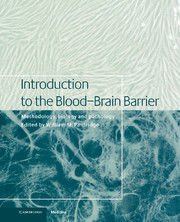Book contents
- Frontmatter
- Contents
- List of contributors
- 1 Blood–brain barrier methodology and biology
- Part I Methodology
- Part II Transport biology
- Part III General aspects of CNS transport
- Part IV Signal transduction/biochemical aspects
- Part V Pathophysiology in disease states
- 41 Cerebral amyloid angiopathy
- 42 Brain microvasculature in multiple sclerosis
- 43 Hemostasis and the blood–brain barrier
- 44 Microvascular pathology in cerebrovascular ischemia
- 45 HIV infection and the blood–brain barrier
- 46 Hypertension
- 47 The blood-brain barrier in brain tumours
- 48 The pathophysiology of blood–brain barrier dysfunction due to traumatic brain injury
- 49 Cerebral malaria and the brain microvasculature
- 50 Molecular basis of tissue tropism of bacterial meningitis
- Index
41 - Cerebral amyloid angiopathy
from Part V - Pathophysiology in disease states
Published online by Cambridge University Press: 10 December 2009
- Frontmatter
- Contents
- List of contributors
- 1 Blood–brain barrier methodology and biology
- Part I Methodology
- Part II Transport biology
- Part III General aspects of CNS transport
- Part IV Signal transduction/biochemical aspects
- Part V Pathophysiology in disease states
- 41 Cerebral amyloid angiopathy
- 42 Brain microvasculature in multiple sclerosis
- 43 Hemostasis and the blood–brain barrier
- 44 Microvascular pathology in cerebrovascular ischemia
- 45 HIV infection and the blood–brain barrier
- 46 Hypertension
- 47 The blood-brain barrier in brain tumours
- 48 The pathophysiology of blood–brain barrier dysfunction due to traumatic brain injury
- 49 Cerebral malaria and the brain microvasculature
- 50 Molecular basis of tissue tropism of bacterial meningitis
- Index
Summary
Introduction
The term cerebral amyloid angiopathy (CAA) (synonymous with cerebral congophilic angiopathy and cerebrovascular amyloidosis) describes and defines a pathologic condition whereby the media of small arteries (arterioles), veins (venules) and adventitial component of capillaries is replaced by one of several fibrillar proteins that have a betapleated sheet configuration (Vinters, 1987). Whereas the older literature differentiates between primarily capillary and arteriolar amyloid deposition, modern conceptualization of CAA defines the microangiopathy based upon the biochemical composition of the primary molecule that constitutes the fibrillar amyloid deposits (Coria and Rubio, 1996). Thus, several forms of CAA are recognized:
CAA associated with Alzheimer disease/senile dementia of Alzheimer type (AD/SDAT), Down's syndrome (DS) and brain aging – biochemically composed of beta/A4 protein – is by far the most common form of CAA worldwide.
CAA in Icelandic patients who suffer from a hereditary form of cerebral hemorrhage – best described by the terms hereditary cerebral hemorrhage with amyloidosis, Icelandic (HCHWA-I); or, since the amyloid protein is a variant of gamma-trace/cystatin C, hereditary cystatin C amyloid angiopathy (HCCAA) (Ólafsson et al., 1996).
CAA in Dutch patients who also experience frequent brain hemorrhage on a hereditary basis – by analogy to the Icelandic condition, referred to as HCHWA-D (Bornebroek et al., 1996; Maat-Schieman et al., 1996).
[…]
- Type
- Chapter
- Information
- Introduction to the Blood-Brain BarrierMethodology, Biology and Pathology, pp. 379 - 385Publisher: Cambridge University PressPrint publication year: 1998
- 6
- Cited by



